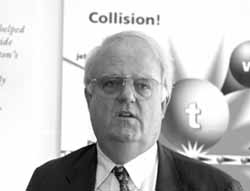 |
|
Saving the Day Mike Perricone
Considering the budget numbers for FY2001 being considered back then, the lab's unofficial general sentiment might have been: "That's good newsˇwhat do crown jewels bring on the open market?"
Now the jewels are safe, thanks to Congressional budget talks that produced a House-Senate conference agreement with more than $3.18 billion for the Department of Energy's Office of Science, including more than $726 million for High-Energy Physics.
"We were originally very disappointed at the level of funding for high-energy physics and for Fermilab," said Fermilab Director Michael Witherell, who has been among the many prominent scientific voices asking for reconsideration of the numbers. "We've come a long way since then. Both the Department of Energy and the Congressional committees recognized the need of doing more for Fermilab and high-energy physics. This budget is significantly better than the original budget request."
Fermilab had faced a shortfall of some $30 million in the original Congressional numbers, but the conference committee pushed the lab's budget up to $277 million. That new level remains short of the lab's estimate ($286 million) for the amount needed to run experimental programs and keep projects on schedule, but Witherell said it was enough to allow Fermilab "to get by this year."
"This puts us back in the position of having a normally tight year, as opposed to the very damaging effect the original budget would have had," Witherell said. "There are some things we won't be able to do as quickly as we would like. But we will not have to make drastic cuts in areas that could not be recovered later, as we would have under the original budget proposal."
Early in the budget revision process, Speaker of the House Dennis Hastert, whose Illinois Congressional District includes Fermilab, expressed his own concerns over the lab's level of funding.
"The Speaker's support for the work at Fermilab is very important to us," Witherell said.
In two important areas--$4 million for the Wilson Hall Safety Improvements Project, and $23 million for NuMI/MINOS construction--the funding was set by line items, which are usually safe from variation.
Still there are adjustments coming into play. Witherell said NuMI/MINOS would face some reduction in the category of "Other Project Costs." These costs are included in the lab's overall operations budget.
There is also an adjustment in next year's funding on the U.S. effort for the Large Hadron Collider at CERN, an adjustment that improved the lab's overall funding picture. Witherell explained that the LHC spending profile (in other words, which expenses are paid for at which times) was restructured in a way that will not affect the project's progress, an effect verified by the LHC managers.
If the budget cloud carried a silver lining, it might have been the mobilization of the science community in communicating the needs and value of research. Witherell cited a letter to Congress from university presidents, a strong message signed by several members of the U.S. House of Representatives, and efforts by user communities in high-energy physics and in all the science disciplines represented at DOE laboratories. He also stressed the long-term importance of a guest column in The Washington Post ("Squeeze on Science," Oct. 4, 2000) by Harold Varmus, president of Memorial Sloan-Kettering Cancer Center and a former director of the National Institutes of Health. Varmus won the Nobel Prize in medicine in 1989.
"It was very helpful for a leader in biomedical research to state that when we talk about the possible doubling of research spending, we should include research in the physical sciences, particularly that supported by the Office of Science," Witherell said.
Witherell added that the Op-Ed piece by Varmus contributed to a growing awareness of the needs and importance of the Office of Science. The $3.18 billion for the Office of Science in the conference committee report was a large boost from the levels originally proposed in both houses of Congress ($2.80 billion in the House, and $2.87 billion in the Senate), and even exceeded the level in the original President's Budget Request ($3.151 billion).
"The Office of Science as a whole gained a lot of attention to the problem of funding," Witherell said. "I think it was very important that people heard that message, that support for the Office of Science has been falling in real terms as opposed to other areas such as biomedical research."
The budget cycle is never ending, and Witherell was clear that FY2002 represented an immediate challenge with crowning achievements such as discovering the Higgs boson seemingly in reach.
"We need to maintain our voice. We need to do better in '02," the director concluded. "We need to get an increase that allows us to carry out both our experimental program, and our accelerator research and development. The scientific opportunities make a very compelling case. We're working very hard on explaining that to people, so we'll be able to start out with a better budget next year."
|
| last modified 10/20/2000 email Fermilab |
FRLsDFx9eyfrPXgV
 Back on March 15, Rep. James Sensenbrenner Jr., (R-Wis.), chairman of the House Science Committee, toured Fermilab and described it as "the jewel in the crown of scientific institutions in the United States."
Back on March 15, Rep. James Sensenbrenner Jr., (R-Wis.), chairman of the House Science Committee, toured Fermilab and described it as "the jewel in the crown of scientific institutions in the United States."